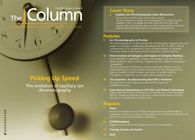Ion Chromatography in Practice
Ion chromatography (IC) is often used for the chromatographic separation of a wide range of compounds. In a laboratory that already uses HPLC or UHPLC, will the implementation of IC be expensive in terms of instrumentation or resources?The Column spoke to Ade Kujore of Cecil Instruments Limited to find out.
Ion chromatography (IC) is often used for the chromatographic separation of inorganic anions or cations in waters, low-molecular-weight organic acids in beverages, drugs in blood plasma, preservatives or vitamins in food, modified sugars in high-throughput screening of new bioactive formulations, ionic chelates in production samples, amino acids in biospecimens, and certain organometallic compounds in metallurgical products. In a laboratory that already uses high performance liquid chromatography (HPLC) or ultrahigh-pressure liquid chromatography (UHPLC), will the implementation of ion chromatography be expensive in terms of instrumentation or resources? The Column spoke to Ade Kujore of Cecil Instruments Limited to find out.
Q: How does ion chromatography differ from high performance liquid chromatography (HPLC) or ultrahigh-pressure liquid chromatography (UHPLC)?

Photo Credit: Radius Images/Getty Images
A. Ion chromatography (IC) is any method for the chromatographic separation of ionic or ionizable species in solution. Many different ions can be analyzed within single elutions. The actual analytical methods and instrumentation are similar to those of high performance liquid chromatography (HPLC) and ultrahigh-pressure liquid chromatography (UHPLC). The main forms of IC are based on one or more of the following interactions:
- Ion-exchange chromatography: This is where ionic interactions occur between analyte ions and polar functional groups in the stationary phase. The stationary phase is a chemically modified silica or styrene-divinylbenzene copolymer resin, onto which ionic side groups are introduced. Examples of the ionic side groups include: Quaternary ammonium groups (strong anion exchanger); tertiary amine group (weak anion exchanger); sulphonic acid (strong cation exchanger); and carboxylic acid (weak cation exchanger). Ion-exchange chromatography is currently the most widely used of all forms of ion chromatography interactions. Increased selectivity in ion-exchange separations are achieved by manipulating the type of counter-ion, ionic strength, and pH of the mobile phase. Further to this, more than one mobile phase can be used to create a gradient, to progressively elute different analytes through the column.
- Ion-exclusion chromatography: This is mainly used for the separation of weak acids such as carboxylic acids, phenols or amino acids, or for weak bases.
- Ion-pair chromatography: Used to separate ions on a reversed-phase column, detection is normally performed using a UV–vis detector. An ion-pair reagent is added to alter the separation and resolution of ions. The separation of complex mixtures of very polar with ionic molecules, such as halides and imidazolium and pyridinium derivatives, or a mixture of artificial sweeteners, is achieved.
Q: Are special instruments or resources required?
A: For current HPLC users who would like to consider using IC, very little time or other resources are required to master this technique. For analysts with modular HPLC systems, the addition of another detector module is required to add versatility to their existing instrumentation systems. A conductivity detector provides universal and sensitive detection of charged species. In the detection of low levels of anions, a suppressor column can be connected in series after the analytical column, so that the conductivity of carbonate or hydroxide eluent is vastly reduced before the eluent reaches the detector.
Amperometric detectors can be used for the extremely highly sensitive detection of some anions such as cyanide, sulphide, and nitrite, and a few cations such as iron III and cobalt II.
As with all detectors, an analyst must consider using a detector which has the lowest possible noise and drift. A column heater/chiller is normally used for ion chromatography analyses. This will also ensure that there is no temperature gradient between the temperature of the column and that of the detector cell. Column heater/chillers also contribute to effective reproducible chromatographic separations.
As with HPLC and UHPLC, IC involves a choice of mobile phases. To ensure a wide as possible choice, an instrumental system that allows the user absolute choice of mobile phase should be used. The choice of mobile phases does not have to entail the use of instrumentation supplementary to that found in an HPLC system. However, some manufacturers do offer proprietary prepared and preconcentrated mobile phase generation systems.
As a result of the leaching of some cations from stainless steel tubing, PEEK or non-metal flow paths are used in IC, to protect metal-sensitive and metal-adsorbing samples, and prevent the contamination of blanks, samples, and standards. Because of the leaching of many ions from glass, mobile phases, blanks, samples, and standards are stored within plastic containers.
Of course, in some situations, an analyst may wish to purchase a modular, or an all-in-one IC system, which are offered by several manufacturers.
Q: Should all IC samples be liquid?
A. Ideally, yes. However, for those intractable solid samples that cannot be easily dissolved, there is a technique of on-line combustion. Samples are oxidized in a combustion furnace at temperatures of about 1000 °C, which pyrolizes the samples. The resultant vapours are then passed to a sparging system, where they are converted to aqueous solutions that are then fed onto an IC system's autosampler injection valve. This combustion IC is used for the analysis of halides and sulphur in pharmaceuticals printed circuit boards, oils, and rocks.
Gas samples may be passed to a sparging type system, as stated above, where they are converted to aqueous solutions that are then fed onto an IC system's autosampler injection valve.
As with HPLC systems, IC may be specially adapted for on-line automatic use in production facilities.
Q: What are the emerging trends in IC?
A. Advances include capillary ion chromatography, where small amounts of sample and mobile phase are required; sequential analysis where one sample is analyzed by two different detectors in sequence or in parallel and simultaneous analysis of anions and cations is performed; hyphenation of ion chromatography to mass spectrometric detectors for improved sensitivities and peak purity analysis; fast and ultrahigh-pressure IC could occur in the future if sub-2-micron columns become available; developments in on-line sample preparation and matrix elimination; 2D chromatography and the increased use of gradients.
Ade Kujore is an analytical biochemist with many years of laboratory experience, within several types of laboratories. She can be contacted at the Marketing department of Cecil Instruments Limited.
E-mail: info@cecilinstruments.com
Website: www.cecilinstruments.com
This article is from The Column. The full issue can be found here:http://images2.advanstar.com/PixelMags/lctc/digitaledition/July07-2014-uk.html#2

Polysorbate Quantification and Degradation Analysis via LC and Charged Aerosol Detection
April 9th 2025Scientists from ThermoFisher Scientific published a review article in the Journal of Chromatography A that provided an overview of HPLC analysis using charged aerosol detection can help with polysorbate quantification.
Removing Double-Stranded RNA Impurities Using Chromatography
April 8th 2025Researchers from Agency for Science, Technology and Research in Singapore recently published a review article exploring how chromatography can be used to remove double-stranded RNA impurities during mRNA therapeutics production.










